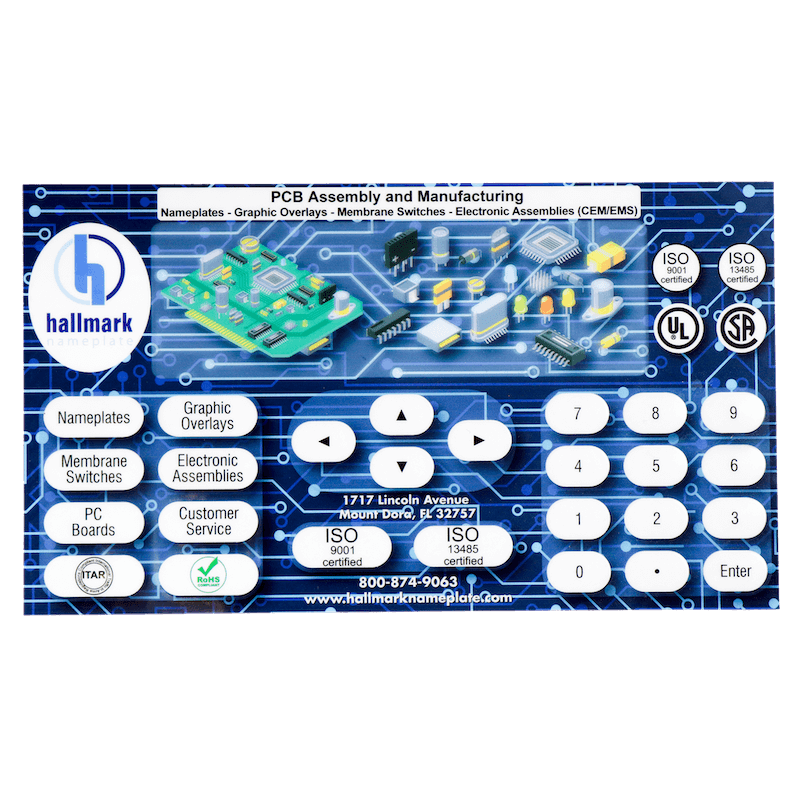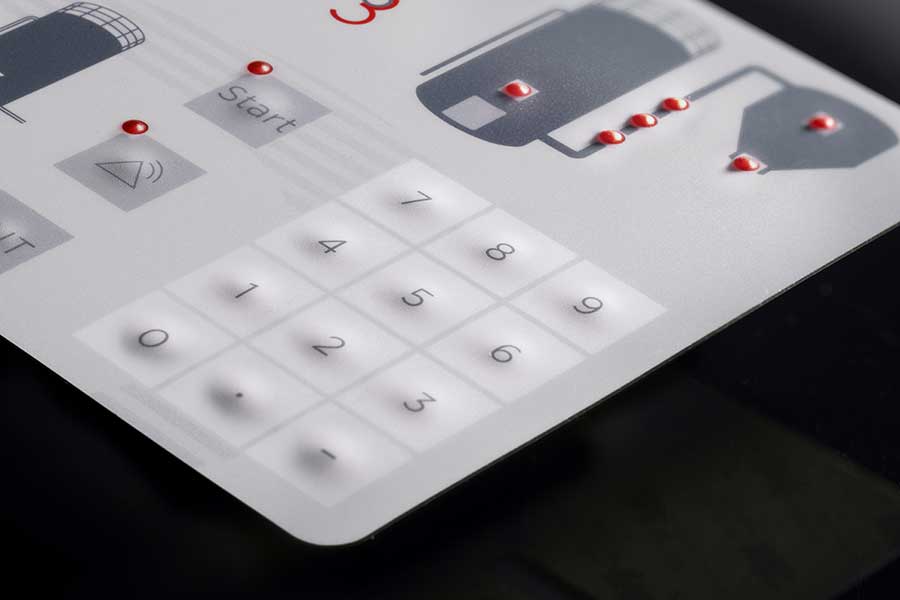Figure out How Membrane Switches Are Tailored to Meet Specific Design Requirements
Figure out How Membrane Switches Are Tailored to Meet Specific Design Requirements
Blog Article
Membrane Switches Explained: A Comprehensive Guide to Their Benefits
Membrane layer switches represent a versatile and sophisticated service for producing interface across a selection of sectors. Their multilayered design not just makes sure functionality with basic stress yet additionally provides considerable advantages, such as durability and personalization. As markets progressively look for dependable and effective control user interfaces, understanding the particular benefits and applications of membrane switches becomes crucial. The complexities of their design and implementation present one-of-a-kind challenges that advantage closer examination. What factors should be taken into consideration to totally leverage their possibility in modern applications?
What Are Membrane Layer Switches?

When stress is put on the membrane layer button, the layers make contact, completing an electric circuit. This basic device permits a vast array of applications, from customer electronics to commercial equipment. Membrane layer switches are frequently made to be waterproof and resistant to dust and contaminants, making them ideal for environments where longevity is important.
Furthermore, the flexibility of the materials utilized in membrane changes assists in cutting-edge layouts that can conform to different forms and dimensions. This flexibility adds to their appeal in diverse fields, including medical devices, automobile controls, and home appliances. In general, membrane changes represent a critical component in contemporary customer interface modern technology, linking the void in between individuals and electronic systems.
Key Advantages of Membrane Layer Buttons
Amongst the myriad of individual interface options available, membrane switches over stand out for their one-of-a-kind mix of advantages. One of the primary advantages is their light-weight and portable style, which enables for combination into a large array of gadgets without adding significant mass. This is especially advantageous in applications where space is restricted.
Furthermore, membrane layer changes offer sturdiness and resistance to environmental variables. They are commonly built with materials that can endure moisture, dirt, and various chemicals, making them ideal for severe conditions. This durability adds to a longer life-span compared to typical mechanical buttons.
One more substantial advantage is the versatility in modification. Membrane buttons can be printed with numerous graphics, colors, and structures, allowing for customized designs that fulfill certain branding or practical demands. This versatility includes the number of layers and circuit alternatives, offering designers with multiple setups.
Additionally, the tactile comments given by some membrane changes enhances individual experience, making them more user-friendly to run. The convenience of cleansing and maintenance further solidifies membrane switches as a functional selection in both consumer and industrial applications. On the whole, these key advantages make them a favored remedy for many developers and makers
Applications in Various Industries
Exactly how do membrane layer buttons discover their area throughout varied sectors? Their flexibility and performance make them integral parts in sectors varying from medical care to customer electronics. In clinical tools, membrane layer buttons are utilized for their ease of cleaning and resistance to contamination, making sure hygiene in atmospheres where sterility is essential.
In the consumer electronics industry, these switches provide streamlined, straightforward interfaces that enhance item visual appeals while maintaining sturdiness against deterioration. Automotive applications take advantage of membrane switches over too, where they are utilized in dashboards and control panels, providing dependable performance in tough problems.
Additionally, commercial machinery employs membrane layer buttons for control board because of their toughness, ability to hold up against rough atmospheres, and check my blog customizable designs that cater to details functional needs. The food market leverages membrane buttons for their simplicity of use and resistance to spills, making certain operational efficiency in busy setups.
Ultimately, the flexibility of membrane switches over throughout these diverse applications emphasizes their necessary role in modern-day technology, boosting user communication while meeting industry-specific needs. Their continued evolution assures more combination right into emerging areas and innovative products.
Style and Customization Choices
The layout and customization options offered for membrane layer switches are vital for customizing interfaces to satisfy particular individual needs and aesthetic preferences. These buttons can be created in various shapes, sizes, and formats, permitting seamless assimilation into diverse applications. The adaptability in design implies that suppliers can create special user interfaces that enhance functionality and preserve brand name identification.
Custom colors, textures, and graphics can be related to the surface area of the membrane layer button, giving an opportunity for branding and individual interaction. Furthermore, backlighting choices, such as LED lighting, can be integrated to enhance exposure in low-light problems, therefore improving performance.
Functional aspects can likewise be personalized, including tactile feedback and actuation pressure, which can be readjusted to fit various individual interactions. The choice of products, such as polyester or polycarbonate, enables variants in toughness and webpage environmental resistance, dealing with the details needs of various sectors.
Eventually, the substantial style and customization abilities of membrane buttons make it possible for firms to produce visually appealing and straightforward user interfaces, making certain that their items satisfy both practical and aesthetic needs properly. Membrane Switches.
Considerations for Execution
Executing membrane layer switches calls for careful factor to consider of different variables to make sure optimum performance and user experience. One of the main considerations is the desired application setting. Aspects such as exposure to wetness, extreme temperatures, and chemical materials can substantially impact the switch's efficiency and longevity. Picking materials that stand up to these problems is important.

Another essential element is the switch's style and format. Guaranteeing that the tactile comments and actuation force align with user assumptions boosts use. Performing customer screening can provide valuable insights into the ideal design.
Additionally, compatibility with electronic parts should be evaluated. The switch's circuitry should straighten with the total system architecture, guaranteeing reputable signal transmission and reducing interference.
Moreover, manufacturing approaches and costs must be assessed. The option between customized layouts and basic designs can lead and influence both spending plan time.
Last but not least, think about repair and maintenance. Membrane layer switches might need specific cleansing and care treatments to preserve their look and performance with time. By attending to these considerations, organizations can apply membrane buttons that satisfy their functional demands while giving a positive customer experience.

Conclusion
Finally, membrane changes represent a sturdy and versatile control interface appropriate for a large range of applications throughout several industries. Their portable style, resistance to ecological aspects, and customizable functions enhance individual experience while meeting certain branding needs. As modern technology remains to progress, the relevance of membrane layer switches in modern-day devices stays substantial, providing both capability and aesthetic allure. Future developments will likely better expand their applications and efficiency in numerous atmospheres.
Membrane changes stand for a innovative and flexible solution for creating individual interfaces across a selection of markets.Comprehending the essential components of contemporary electronic interfaces, membrane switches are a type of user interface gadget that consist of versatile, thin layers of material. In general, membrane switches stand for a crucial component in modern-day customer interface modern technology, connecting the space between users and digital systems.
Amongst the myriad of customer interface options readily available, membrane switches over stand out for their unique combination of benefits.The style and modification choices offered for membrane buttons i was reading this are critical for customizing interfaces to fulfill specific individual demands and visual preferences.
Report this page